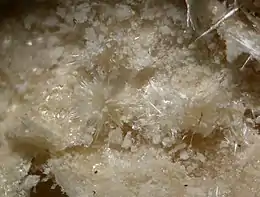| Mascagnite | |
|---|---|
 Acicular crystals and flakes of Mascagnite | |
| General | |
| Category | Sulfate mineral |
| Formula (repeating unit) | (NH4)2SO4 |
| IMA symbol | Msc[1] |
| Strunz classification | 7.AD.05 |
| Crystal system | Orthorhombic |
| Crystal class | Dipyramidal (mmm) H-M symbol: (2/m 2/m 2/m) |
| Space group | Pnam |
| Identification | |
| Color | Colorless, grey, yellowish-grey, yellow |
| Cleavage | Distinct/ good On {001} |
| Fracture | Irregular/ uneven |
| Tenacity | Sectile |
| Mohs scale hardness | 2 - 2+1⁄2 |
| Luster | Vitreous, dull |
| Diaphaneity | Transparent, translucent, opaque |
| Density | 1.768 g/cm3 |
| References | [2][3][4][5] |
Mascagnite is a rare ammonium sulfate mineral (NH4)2SO4. It crystallizes in the orthorhombic system typically forming as stalactitic masses exhibiting good cleavage. It is soft (not higher than 2.5 on the Mohs Scale) and water-soluble. Optical properties are variable; the purest form is transparent and colorless, but opaque gray or yellow deposits are also known.
It occurs in fumaroles, as at Mount Vesuvius and associated with coal seam fires. It was named for Italian anatomist Paolo Mascagni (1752–1815) who first described the mineral.
References
- ↑ Warr, L.N. (2021). "IMA–CNMNC approved mineral symbols". Mineralogical Magazine. 85 (3): 291–320. Bibcode:2021MinM...85..291W. doi:10.1180/mgm.2021.43. S2CID 235729616.
- ↑ Mineralienatlas
- ↑ Mineral Handbook
- ↑ Webmineral Data
- ↑ Mindat
This article is issued from Wikipedia. The text is licensed under Creative Commons - Attribution - Sharealike. Additional terms may apply for the media files.